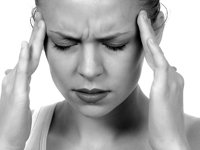If you are a migraine sufferer, you most likely have at least a few things on your list to avoid everyday headaches. Items such as wine, certain cheeses, and caffeine are known to trigger the terrible headaches in many people. But while it’s not all that difficult to eliminate coffee from your daily routine (for most of us), you may not have such an easy time controlling the weather. And new research has found that changes in the weather can bring on migraines in some people.
The study, conducted at Taipei Veterans Hospital in Taiwan, discovered a strong association between the weather and milder migraines, which may not be a factor that many people consider when they think about what might have been their trigger.1 There were 66 participants in the experiment, all of whom had a history of migraines. For a one-year period, they recorded each time a migraine came on as well as what the possible triggers might have been. More than 50 percent of the volunteers noticed a link between the headaches and changes in the temperature.
When the researchers analyzed the data, they found that the weather pattern truly seemed to influence the formation of the migraines in approximately 20 percent of the cases. It was more pronounced when weather was particularly cold than in hotter weather. And these weather changes tended to set off milder migraines more commonly than stronger, more severe headaches.
Not all migraine sufferers are aware that the weather can be a potential trigger for some of them. It is, in fact, one of the most common factors. Changes in barometric pressure, strong sunshine, and rainy weather have all been known to set migraines in motion. Stress is actually the number one most frequent trigger. Some of the other most prevalent triggers are certain foods as mentioned earlier, changes in your sleep pattern, hormone fluctuations in women, skipping meals, bright light, and strong odors.2 Many people who experience migraines are able to pinpoint one or more of these (or other) factors as triggers, while others never figure out just what sets them off.
Triggers may get a migraine rolling, but they are not an actual cause of the headache. Migraines are really due to a combination of heredity and the environment. These types of headaches strongly run in families; if one parent has a history of getting migraines, the child has a 50 percent chance of developing them too, and if both parents are migraine sufferers, the risk is increased to 75 percent for the child.3 Scientists are not sure exactly how migraines form, but they are believed to stem from changes in serotonin levels in the brain. Serotonin is a neurotransmitter that helps different parts of the brain send signals to each other. It affects many of our bodily systems, including mood, sleep, appetite, and memory.
Two-thirds of migraine sufferers are women, and they tend to strike 20 to 50-year-olds the most.4 Migraines typically last somewhere between four hours and three days and can provoke feelings of nausea, a throbbing sensation on one side of the head, visual disturbances, and sensitivity to lights, sounds, and smells. They can be truly debilitating to those who get migraine attacks frequently.
If you do suffer from weather-related migraines, your doctor may suggest taking a pharmaceutical medication. All of the drugs prescribed to treat migraines have side effects and many of them are potentially serious. Aside from chest pain, nausea, dizziness, and muscle weakness, they have been linked to stroke and heart attack. So what’s a person getting migraines to do? First of all, pay attention to your triggers. Keep a journal so you can determine patterns to the headaches and figure out what may be bringing them on. Then, make the necessary effort to avoid all suspected triggers. Obviously if the weather is a trigger, there isn’t much you can do about it. But you can minimize other potential triggers by getting enough rest, eating well, and de-stressing when impending weather changes may cause problems. And try supplementation with natural progesterone creme. Because migraines are so closely associated with hormone levels, a little transdermal progesterone applied to the temples, back of the neck, and forehead can help relieve migraines quickly and completely for many people.
1 Mann, Denise. “Weather Triggers Migraine Headaches.” WebMD. 21 June 2012. Accessed 26 June 2012. <http://www.webmd.com/migraines-headaches/news/20120621/weather-triggers-migraine-headaches>.
2 Mayo Clinic Staff. “Migraine Causes.” Mayo Clinic. 4 June 2011. Accessed 27 June 2012. <http://www.mayoclinic.com/health/migraine-headache/ds00120/dsection=causes>.
3 “Frequently Asked Questions About Headaches.” WebMD. 9 May 2012. Accessed 27 June 2012. <http://www.webmd.com/migraines-headaches/guide/headaches-faq>.
4 “What is migraine?” Migraine.org. August 2011. Accessed 27 June 2012. <http://www.migraine.org.uk/index.php?sectionid=33>.











